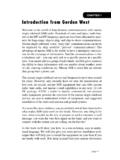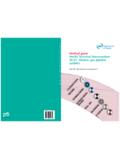Transcription of Telephone History Series - Telephone Tribute Home Page
1 'sTelephone History Seriesby Tom Farley215 19th StreetWest Sacramento, California and .pdf formattingbyDave Telephone History Series by Tom Farley 1 Private Line's Telephone HistoryPart 1 -- to 1830"We picture inventors as heroes with thegenius to recognize and solve a society'sproblems. In reality, the greatest inventorshave been tinkerers who loved tinkering for itsown sake and who then had to figure out what,if anything, their devices might be good for."Jared DiamondI. IntroductionII. Early Telephone Development III. TheInventors: Gray and BellI. Introduction" .. an inspired black-haired Scotsman oftwenty eight, on theeve of marriage,vibrant and alive tonew ideas." AlexanderGraham Bell : The Lifeand Times of the ManWho Invented theTelephoneOn March 10, 1876, in Boston,Massachusetts, Alexander Graham Bellinvented the Telephone .
2 Thomas Watsonfashioned the device itself; a crude thingmade of a wooden stand, a funnel, a cup ofacid, and some copper wire. But thesesimple parts and the equally simple firsttelephone call -- "Mr. Watson, come here,I want you!" -- belie a complicated filed his application just hours beforehis competitor, Elisha Gray, filed notice tosoon patent a Telephone himself. What'smore, though neither man had actuallybuilt a working Telephone , Bell made histelephone operate three weeks later usingideas outlined in Gray's Notice ofInvention, methods Bell did not propose inhis own aside for now, the story of thetelephone is the story of invention developed new and original ideas butdid so by building on older ideas anddevelopments. Bell succeeded specificallybecause he understood acoustics, the studyof sound, and something about inventors knew electricity well butlittle of acoustics.
3 The Telephone is ashared accomplishment among manypioneers, therefore, although the credit andrewards were not shared equally. That,too, is often the story of comes from the Greek wordtele, meaning from afar, and phone,meaning voice or voiced sound. Generally,a Telephone is any device which conveyssound over a distance. A string Telephone ,a megaphone, or a speaking tube might beconsidered telephonic instruments but forour purposes they are not transmit sound mechanically andnot electrically. How's that?Speech is sound in motion. Talkingproduces acoustic pressure. Speaking intothe can of a string Telephone , for example,makes the line vibrate, causing soundwaves to travel from one end of thestretched line to the other. A Telephone bycomparison, reproduces sound byelectrical means. What the Victorianscalled "talking by lightning."A standard dictionary defines thetelephone as "an apparatus for reproducingsound, especially that of the voice, at agreat distance, by means of electricity;consisting of transmitting and receivinginstruments connected by a line or wirewhich conveys the electric current.
4 "Electricity operates the Telephone and 's Telephone History Series by Tom Farley 2carries your voice. With that importantpoint established, let's look at here for a very large imagedemonstrating how a Telephone worksModern telephones use electretmicrophones for transmitters andpiezoelectric transducers for receivers butthe principle described is the same. Soundwaves picked up by an electretmicrophone causes "a thin, metal-coatedplastic diaphragm to vibrate, producingvariations in an electric field across a tinyair gap between the diaphragm and anelectrode."[B] A piezoelectric transduceruses material which converts themechanical stress of a sound wave upon itinto a varying electrical History begins, perhaps, at thestart of human History . Man has alwayswanted to communicate from afar. Peoplehave used smoke signals, mirrors, jungledrums, carrier pigeons and semaphores toget a message from one point to a phone was something new.
5 Somesay Francis Bacon predicted the telephonein 1627, however, his book New Utopiaonly described a long speaking tube. Areal Telephone could not be invented untilthe electrical age began. And even then itdidn't seem desirable. The electricalprinciples needed to build a telephonewere known in 1831 but it wasn't until1854 that Bourseul suggested transmittingspeech electrically. And it wasn't until 22years later in 1876 that the idea became areality. But before then, a Telephone mighthave been impossible to form in one' Da Vinci predicted flight and JulesVerne envisioned space travel, people didnot lie awake through the centuriesdreaming of making a call. How couldthey? With little knowledge of electricity,let alone the idea that it could carry aconversation, how could people dream of atelephonic future? Who in the fifteenthcentury might have imagined a pay phoneon the street corner or a fax machine ontheir desk?
6 You didn't have then, an easilyvisualized goal among people likepowered flight, resulting in one inventorafter another working through the years torealize a common goal. Telephonedevelopment instead was a Series of often-disconnected events, mostly electrical,some accidental, that made the telephonepossible. I'll cover just a are many ways to communicateover long distances. I have reproduced anice color diagram which shows theRoman alphabet, the international flagcode, Morse Code, and semaphoresignaling. Click here to viewII. Early TelephoneDevelopmentFor moreinformation onLeyden jars,includingphotographsandinstructions onhow to buildthem, go thispage at theStaticGenerator site: ~ 's Telephone History Series by Tom Farley 3In 1729 English chemist Stephen Graytransmitted electricity over a wire.
7 He sentcharges nearly 300 feet over brass wireand moistened thread. An electrostaticgenerator powered his experiments, onecharge at a time. A few years later,Dutchman Pieter van Musschenbroek andGerman Ewald Georg von Kleist in 1746independently developed the Leyden jar, asort of battery or condenser for storingstatic electricity. Named for its Hollandcity of invention, the jar was a glass bottlelined inside and out with tin or lead. Theglass sandwiched between the metal sheetsstored electricity; a strong charge could bekept for a few days and transported. Overthe years these jars were used in countlessexperiments, lectures, and 1753 an anonymous writer, possiblyphysician Charles Morrison, suggested inThe Scot's Magazine that electricity mighttransmit messages. He thought up ascheme using separate wires to representeach letter. An electrostatic generator, heposited, could electrify each line in turn,attracting a bit of paper by static charge onthe other end.
8 By noting which paperletters were attracted one might spell out amessage. Needing wires by the dozen,signals got transmitted a mile or labored with telegraphs like this formany decades. Experiments continuedslowly until 1800. Many inventors workedalone, misunderstood earlier discoveries,or spent time producing results alreadyachieved. Poor equipment didn't helpeither. Balky electrostatic generatorsproduced static electricity by friction,often by spinning leather against while static electricity could makehair stand on end or throw sparks, itcouldn't provide the energy to do trulyuseful things. Inventors and industryneeded a reliable and continuous 1800 Alessandro Volta produced thefirst battery. A major development, Volta'sbattery provided sustained low poweredelectric current at high cost. Chemicallybased, as all batteries are, the batteryimproved quickly and became theelectrical source for further while batteries got more reliable, theystill couldn't produce the power needed towork machinery, light cities, or provideheat.
9 And although batteries would worktelegraph and Telephone systems, and stilldo, transmitting speech requiredunderstanding two related elements,namely, electricity and an easy to read introduction and a link to acomprehensive article on Volta, visit RjC's site: 1820 Danish physicist Christian Oersteddemonstrated electromagnetism, thecritical idea needed to develop electricalpower and to communicate. In a famousexperiment at his University ofCopenhagen classroom, Oersted pushed acompass under a live electric wire. Thiscaused its needle to turn from pointingnorth, as if acted on by a larger discovered that an electric currentcreates a magnetic field. But could amagnetic field create electricity? If so, anew source of power beckoned. And theprinciple of electromagnetism, if fullyunderstood and applied, promised a newera of communicationFor an excellent summary of ChristianOersted's life, visit: 1821 Michael Faradayreversed Oersted's experiment.
10 Hegot a weak current to flow in a wirerevolving around a permanentmagnet. In other words, a magneticfield caused or induced an electriccurrent to flow in a nearby wire. Inso doing, Faraday had built theworld's first electric energy could now 's Telephone History Series by Tom Farley 4converted to electrical energy. Is thatclear? This is a very important simple act of moving ones' handcaused current to move. Mechanicalenergy into electrical energy. Althoughmany years away, a dynamo poweredturbine would let the power of flowingwater or burning coal produce a river or a dam? The water spins theturbines which turns the generators whichproduce electricity. The more water youhave the more generators you can add andthe more electricity you can energy into electrical energy.(By comparison, a motor turns electricalenergy into mechanical energy.)








